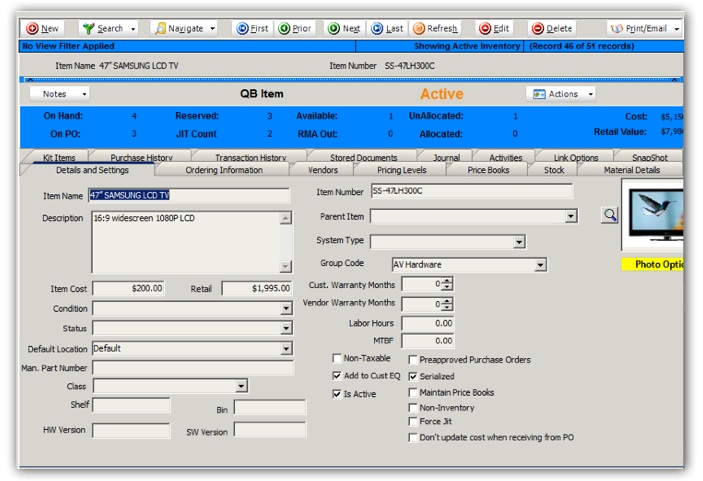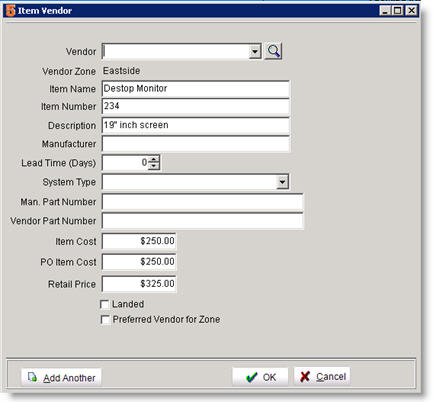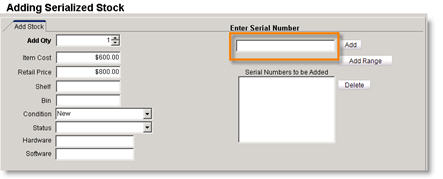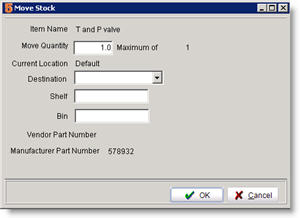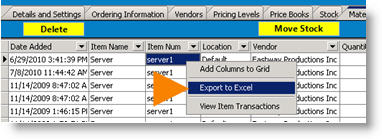Inventory
In the Inventory section of the Inventory module you can setup and access all inventory items. View stock for the item, move stock between warehouses, view item purchase history, and setup ordering information for the item. You can also initiate a PO from the inventory item.
Inventory Item Summary
In each inventory item you can track your stock levels and see how many parts are available for orders and how many parts are reserved on orders.
Circled in the image below, you will see the inventory summary for an inventory item.
On Hand
|
The quantity of stock in your warehouses.
On Hand increases when stock is added to your warehouses, decreases when stock is delivered to customer (reserved on an order and the order is closed) |
Allocated
|
Number of parts requested to be reserved for a service order, install orders, or itemized invoices. |
Reserved
|
The number of parts applied to service orders, install orders, or itemized invoices.
|
Unallocated
|
The number of parts that are available to allocate to an order (parts available to request to reserve on an order) |
Available
|
The number of parts in your warehouses that aren’t reserved. (on hand – reserved = available) |
ON PO - Number of items on purchase orders
RMA Out – Number of items on return
Cost – The cost of all stock available for the item (On the Material Details tab, Quantity * Item Cost)
Retail Value – the retail value for all stock available for the item (On the Material Details tab, sum up Quantity * Item Retail)
Create a New Inventory Item
If you are syncing SME with QuickBooks and you have inventory items in QuickBooks, your inventory items will be imported. If you are not syncing with QuickBooks, this is how you can create inventory items in SME.
1. In the Inventory module, click Inventory.
2. Click New.
Details and Settings Tab
|
Description of Fields | |
|
Item Name |
Name of the inventory item |
|
Description |
Description of the inventory item |
|
Item Cost |
Your cost to buy this item |
|
Retail |
The amount you sell this item for |
|
Condition |
Select a general condition for the item. |
|
Status |
You can customize the drop down values to describe the status of the items |
|
Default Location |
Select the warehouse you are using to store this item. When adding material to orders, SME will first look in the default location. |
|
Man. Part Number |
Manufacturer part number |
|
Class |
Select the Class. Classes are imported from QuickBooks. |
|
Shelf and Bin |
Enter where you are storing the item in the warehouse |
|
HW and SW Version |
Hardware and Software Version |
|
Item Number |
You can type the barcode number here |
|
System Type |
Used to designate major systems of inventory or customer equipment. |
|
Group code |
Used to group or categorize parts. For example, plumbing, electrical, etc. |
|
Cust. Warranty Months |
Enter the warranty period you offer your customers for this part |
|
Vendor Warranty Months |
Enter the warranty period your vendor offers you |
|
Labor Hours |
Enter the estimated labor hours associated with this item. When this item is added to an order, your user will be prompted to add those labor hours in the Labor Editor window. |
|
MTBF |
Enter mean time before failure is applicable |
|
Non –Taxable |
Check here if this item is non-taxable |
|
Add to Cust EQ |
If this is checked, when this item is added to an order, the item will be automatically added to the customer equipment list. Check this for all major items. |
|
Is Active |
Check if the item is active |
|
Serialized |
Check here if this is a serialized part |
|
Maintain Price Books |
When the cost/retail is changed in the price book (depending on settings), then all records with this flag checked will also be updated. |
|
Non-Inventory |
Check here if you don’t want to track inventory on this item. For example, with a bucket of screws you might not want to count every item in the bucket. |
Ordering Information Tab
On the Ordering Information tab, you setup ordering information such as the vendor, minimum quantity on hand and the reorder amount. Below is a description of all the fields on this tab.
Minimum On Hand – Enter the minimum quantity you want in stock in your warehouse.
Reorder Quantity – Set the quantity you want to reorder if you hit your minimum threshold.
Quantity Sold YTD – This is a calculated field that shows you how many you have sold year to date. The field is updated when the order containing the item is invoiced.
Count required to fill orders (JIT) – The number of items tied to orders
Manufacturer – Enter the part manufacturer.
Vendor – Select your default vendor. When placing a PO for this item from an order, this vendor automatically populates the vendor field.
Lead Time (Days) - The typical time it takes the vendor to deliver the part. Used as a reference field.
Count Cycle – Select how often you want to count this inventory item (e.g. annually, quarterly, or monthly)
Unit Of Measure – Reference field for the items unit of measure (feet, lbs, etc).
Item Weight (lbs) – Enter the item weight as reference.
Last Sold Date – The last date the item was sold.
Last Order Date –The last date the item was placed on a Purchase Order.
Last Received Date – The last date the item was received into inventory on a Purchase Order.
Last Reconciliation Date – The last date the item quantities were reconciled using the Inventory Reconciliation utility.
Vendors Tab
On the Vendor tab, enter additional vendors that supply this part.
|
Vendor |
Select the vendor from the drop down list. |
|
Vendor Zone |
Shows the zone assigned to the vendor. |
|
Item name, Number and Description |
Populated from the inventory item |
|
Manufacturer |
Enter the manufacturer of the item |
|
Lead Time |
Enter the vendors lead time |
|
System type & Man. Part Number |
Populated from the inventory items Defaults and Settings tab. |
|
Vendor Part Number |
Enter your vendor’s part number |
|
Item Cost, PO Item Cost and Retail Price |
Populated from the inventory item Defaults and Settings tab. |
Stock Tab
On the Stock tab, you will see a summary of stock for each warehouse location. You can see the stock quantity, the amount reserved, and the amount of stock available at each location. Although the inventory count information is shown on the main page of the inventory item, it is not directly editable as an item. Instead stock levels are controlled through adding of stock (typically only initially), purchase orders (PO's), and inventory reconciliation adjustments.
Add Stock Item
Once you get started using SME, you will add stock to inventory through purchase orders. When getting started setting up your stock in SME, you may need to manually enter stock.
*NOTE* If you are tracking inventory quantities in QuickBooks, any stock manually entered in SME using “Add Stock Items” will also need to be entered into QuickBooks. Only invoices from SME automatically deplete inventory in QuickBooks. Only POs or Bills from SME automatically increase inventory in QuickBooks. Therefore, it is recommended for most stock transactions to go through purchase orders.
Adding Non-Serialized Stock
- Select the inventory item you need to add stock for.
- Select the Stock tab.
- Click Add Stock Items.
- In the top portion of the Inventory Stock Editor window, you can change the warehouse you are adding stock to.
- Update the quantity in the Add Qty field.
- Enter additional information such as condition, shelf and bin number.
- Click OK and the stock is added to inventory. Notice the summary quantities at the top of the inventory item.
View Stock Details in Warehouses
To see stock details by warehouse location and change serial numbers, you can use the Inventory Stock Editor.
- On the Stock tab, select the warehouse location you want to edit.
- Click Edit.
- The material details for that stock warehouse location will open in the Inventory Stock Editor.
- You can right click on a material detail item to edit the serial number.
Material Details Tab
The Material Details tab provides details on all the material for this inventory item. For serialized items, the Material Details tab shows each stock item on a separate line. Notice the Quantity, Reserved, Available and Serial # columns. For non-serialized items each line is a stock lot, meaning something is different in each lot such as vendor or pricing.
Move stock to another warhouse
This allows the movement of individual stock items. If items are moved to a warehouse, that warehouse will be created in Stock tab if it does not already show.
1. On the Material Details tab, select the stock you need to move.
2. Click Move Stock.
3. In the Move Stock window, select the warehouse you are moving the item to in the Destination field. Enter Shelf and Bin if applicable.
If you are moving non-serialized stock, you may be moving part of a stock lot. Enter the quantity from the lot you want to move in the Move Quantity field.
4. Click OK.
5. Notice the location change on the Material Details tab and the Stock tab.
View stock item transactions
To view the history of transactions for material:
1. Select the Material Details tab.
2. Right click on item.
3. Select View Item Transactions.
4. The transaction history will open in another window. (image on right)
5. Click OK.
Export material details to Excel
1. Select the Material Details tab. 2. Right click in the grid and select Export to Excel (image on right). 3. Select where you want to save the file and click Save
Kit Items
When you add material to an order, you may need to know what parts go with that material. You can add this related material on the Kit Items tab. When you are adding the material to an order, you can reference the kit items so you know what other material you may need to add to the order.
Add kit items to an inventory item
- Go to an inventory item in the Inventory module.
- Select the Kit Items tab.
- Click Add Kit Item.
- Click Select Inventory and select the inventory item.
- Click OK.
Referencing kit items in an order
- Create a new order.
- Click the Order Items tab.
- Click New Materials.
- Select the inventory item you created the kit for.
- In the window that opens, select the Kit Items tab and you will see the material in the associated kit.
- Click OK.
Purchase History
The purchase history tab provides information about all purchase orders placed for the inventory item. Double click on a line in the grid, and SME will jump to the purchase order.

